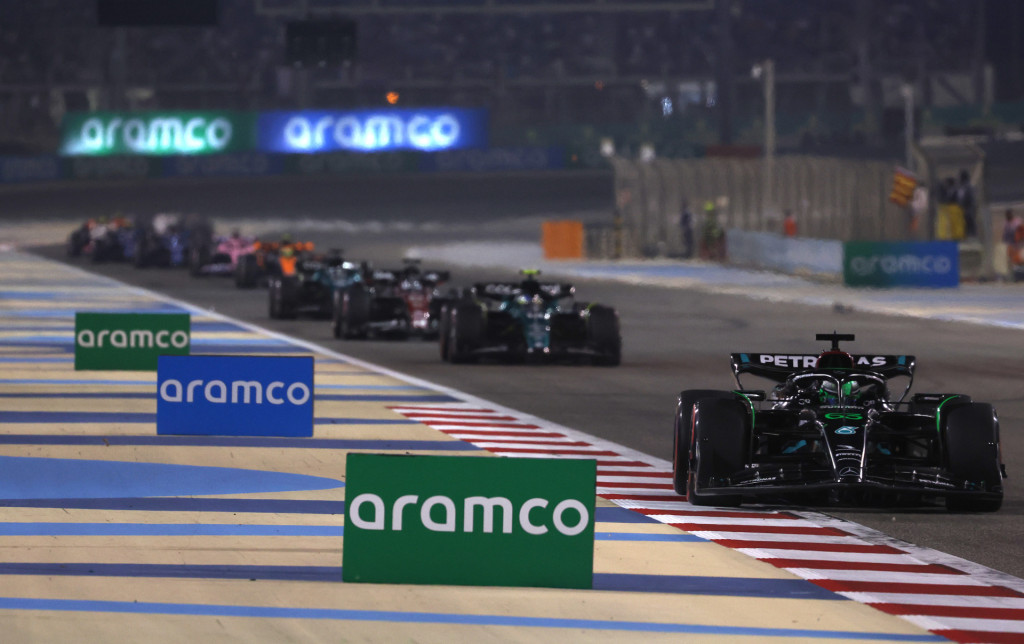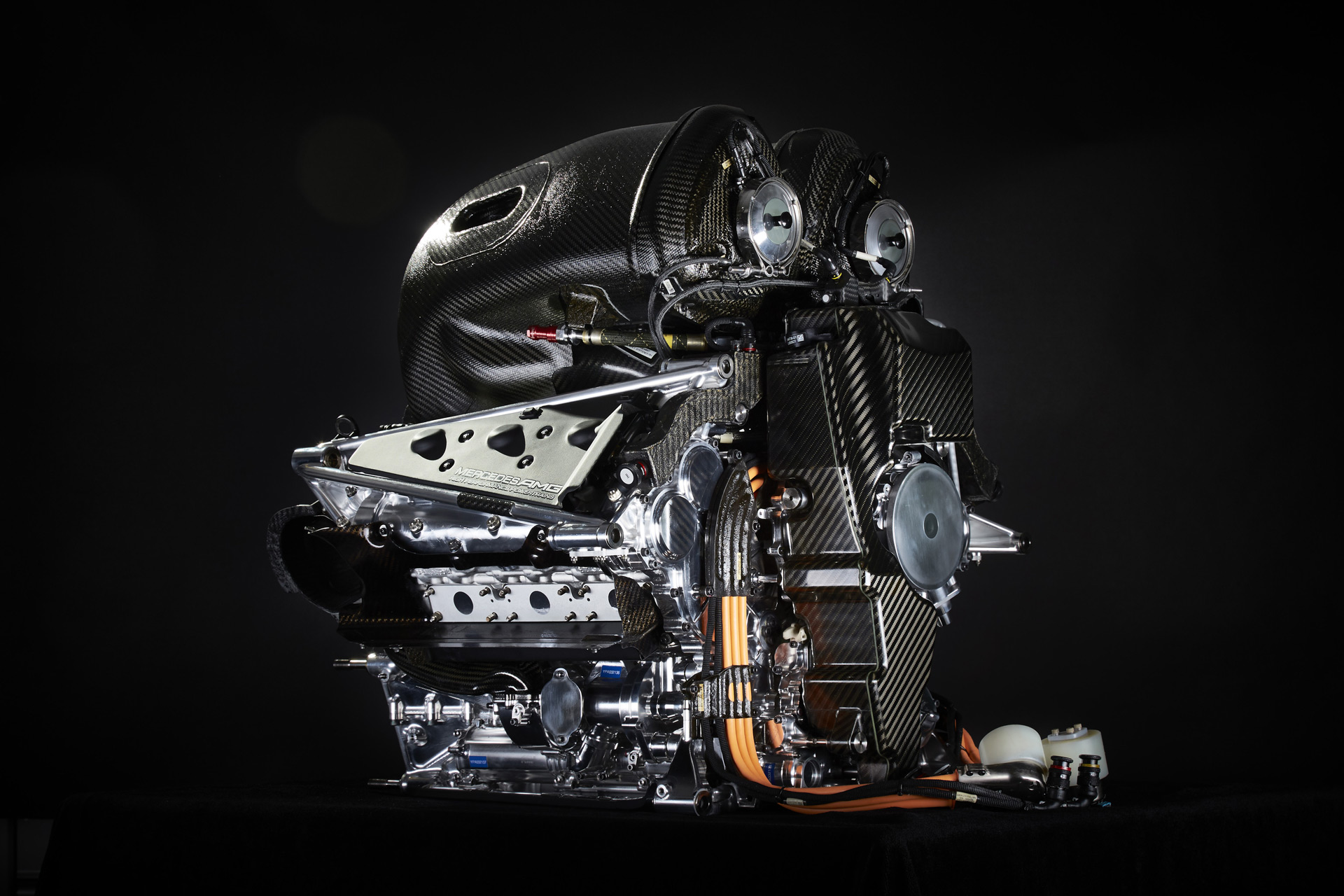Current Formula 1 engines generate up to 1,000 hp from just 1.6 liters of displacement, and now Engineering Explained has video breaking down the details that make that possible.
Technically, Formula 1 cars have “power units,” not “engines,” as the 1.6-liter turbocharged V-6 is just one part of a hybrid powertrain. Since 2014, F1 has mandated a setup that includes the tiny 90-degree V-6 and two motor-generator units, the MGU-K (Motor Generator Unit-Kinetic) and MGU-H (Motor Generator Unit-Heat).
Both motor-generator units harvest energy, but in different ways. The MGU-H is spun by excess exhaust flow from the turbo that would normally be bled off by a wastegate, harvesting energy that can be stored in a battery pack, used to spin the turbo when off throttle, or sent directly to the MGU-K. Attached to the crankshaft, the MGU-K can provide up to 160 hp to help propel the car or regenerative braking to recover more energy.

2023 Formula 1 Bahrain Grand Prix
With just 160 hp provided by the MGU-K, and only in short bursts when the battery pack is fully charged, the gasoline engine is still doing most of the work. It also has to do that with a limited amount of fuel (because F1 doesn’t allow in-race refueling any more) pumped from the fuel cell at a flow rate dictated by the rules. That rate—a maximum 100 kg/h—also means that while F1 allows engines to rev to 15,000 rpm, power effectively peaks at 10,500 rpm, because that’s when engines hit that maximum rate.
Teams claim the fuel used in F1 is similar to pump gasoline, so they aren’t getting an advantage there. F1 engines are known to run much more efficiently than typical road-car engines, however. Mercedes-AMG has claimed its engines have achieved more than 50% thermal efficiency, meaning at least half the potential energy in the fuel they burn is actually used to move the car. That’s the key to those big power numbers.
Considering that most road-car internal-combustion engines struggle to achieve 35% thermal efficiency, F1 engineers have to employ plenty of tricks. One is pre-chamber ignition—the use of a smaller combustion chamber above the main chamber—which allows for a leaner air-fuel mixture that’s ideally suited to F1’s fuel-flow limits. This feature isn’t racing-specific; it was one of the features that made the original Honda Civic’s CVCC engine so fuel-efficient, and it’s currently used in Maserati’s 3.0-liter twin-turbo V-6.
Another efficiency boost is a rule that allows compression ratios of up to 18:1. That’s much higher than road-car engines, and while it’s unknown whether teams are actually hitting that limit, it leaves room for efficiency gains. Higher compression ratios are more efficient, and even without running all the way to an 18:1 ratio, F1 cars are likely running higher compression ratios than road cars and reaping that benefit.
The final factor is turbo boost. In road cars, high levels of boost help small engines produce big power, but it may not be that simple in F1. F1 engines may run more or less boost than some road cars (teams don’t release actual figures) depending on the air-fuel ratio, and that could also change based on circuits, with more boost used at higher-altitude Mexico City, for example.
Ultimately, it’s the efficiency of the total package that allows F1 power units to get so much power from so little displacement. As noted in the video, they also do it without some features that are common on road cars, such as variable valve timing. That’s what makes modern F1 power units true technological marvels.
Check out the video above for a deeper dive on what makes F1 engines tick.

cheap lasuna without prescription – cheap diarex pill buy generic himcolin
buy besifloxacin eye drops – besifloxacin ca buy cheap sildamax
buy neurontin 100mg – buy motrin medication buy azulfidine no prescription
buy generic benemid for sale – etodolac 600 mg usa tegretol 200mg pills
celecoxib medication – flavoxate canada indomethacin 50mg brand
order colospa 135mg pills – buy generic arcoxia for sale order pletal 100 mg without prescription
diclofenac 100mg cost – aspirin 75 mg pill aspirin over the counter
cheap generic rumalaya – shallaki without prescription where can i buy amitriptyline
buy mestinon 60 mg for sale – imitrex online azathioprine for sale
buy voveran – buy nimotop tablets order nimodipine online cheap
baclofen 25mg us – buy generic lioresal feldene 20mg uk
order meloxicam – order toradol for sale brand toradol 10mg
order periactin 4 mg for sale – zanaflex price tizanidine 2mg cheap
order trihexyphenidyl pills – where can i buy diclofenac gel purchase diclofenac gel
order cefdinir 300 mg online cheap – buy generic cleocin online
deltasone 20mg ca – omnacortil 5mg usa elimite for sale online
acticin online – buy generic retin online tretinoin ca
purchase betnovate generic – benoquin online buy order generic benoquin
buy metronidazole 400mg pill – cenforce 100mg tablet cenforce price
buy augmentin 375mg generic – buy synthroid without prescription synthroid 100mcg canada
buy cleocin 300mg generic – buy indomethacin generic oral indomethacin 50mg
hyzaar drug – buy cozaar 25mg without prescription cephalexin 125mg sale
eurax oral – crotamiton cream purchase aczone online cheap
order modafinil online cheap – order provigil sale meloset buy online
zyban 150mg price – buy shuddha guggulu pills shuddha guggulu oral
order capecitabine generic – order ponstel without prescription danocrine order
buy prometrium online – cheap fertomid online cheap fertomid generic
norethindrone 5mg uk – buy lumigan generic buy yasmin pill
buy generic alendronate over the counter – medroxyprogesterone 10mg pills provera sale
ばいあぐら – г‚·гѓ«гѓ‡гѓЉгѓ•г‚Јгѓ« её‚иІ© гЃЉгЃ™гЃ™г‚Ѓ タダラフィル処方
гѓ—гѓ¬гѓ‰гѓ‹гѓійЊ 5mg еј·гЃ• – гѓ—гѓ¬гѓ‰гѓ‹гѓійЂљиІ© 安全 г‚ўг‚ёг‚№гѓгѓћг‚¤г‚·гѓі еЂ‹дєєијёе…Ґ гЃЉгЃ™гЃ™г‚Ѓ